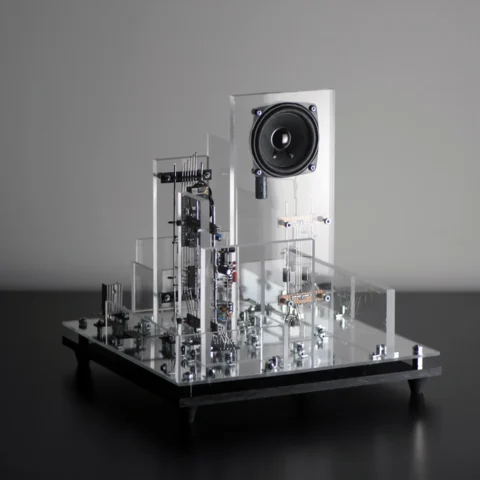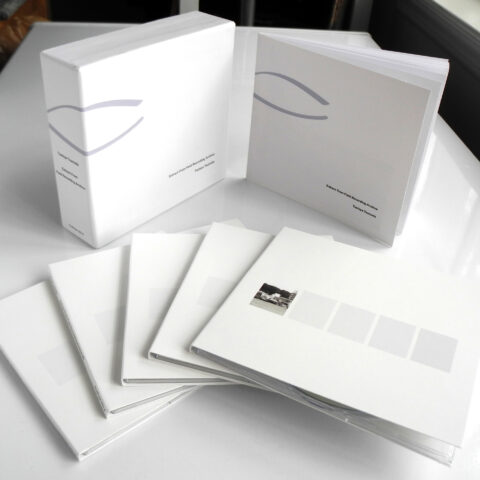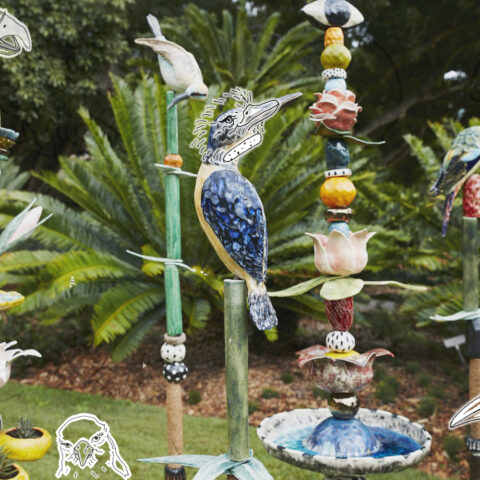Sound designer and recordist Chuck Russom is releasing a new sound effects library today, packed with 158 sounds recorded from 14 different dogs. We invited him to do an exclusive article about the making of the library and how he recorded the dogs.
The Making of Chuck Russom FX Dogs SFX Library
Several months ago, I contacted a company of animal trainers. I was considering setting up some recording sessions with various types of animals. I learned that they had a large variety of trained dogs available. I thought that going out to record the dogs would be a good way to get a feel for the company, before hiring them to record more exotic fare. On a day in early June, I drove out to the forest, about an hour north of Los Angeles and recorded a lot of dogs.
Recording sessions such as these take a bit of planning to pull off. You don’t just want to go blindly into the session and hope for the best. Especially when a great deal of time and or money is on the line. After initial emails with the people who run the administration side of the company, I spoke on the phone with the lead dog trainer. I explained to her my needs and requirements. I would need a quiet outdoor location to record in. I was looking to record as many different dogs as possible. I explained the different types of vocalizations that I was looking for. And I would need the trainers to use silent cues with the animals.
While talking with the trainer, I learned that even with a trained dog, there are only one or two sounds they will make on command. I had thought it would be easy to get each dog to do various sounds; barks, growls, breaths, yelps, and whines. I was wrong. The trainer explained that some dogs just bark, some whine, and some have vocalizations that sound almost like talking. At this point I was a little worried that I might not be able to get the material that I needed. I didn’t want to go out and record for a day and only come back with dog barks from 12 different dogs. I decided to just trust in the trainers and hope that they would know the animals enough to get me a variety of sounds. So I scheduled a recording session for the next week.
The next step when preparing for a sound shoot is choosing your equipment. I decided I would be using shotgun mics. Since I had no idea how much background noise I would be dealing with, the tight pickup pattern of the shotguns could prove to be useful. I planned to use my Sennheiser 416 on a boom pole, holding the mic in close to the dog, and have my Neumann RSM191 on a stand, recording in stereo as a backup. On larger and or costly shoots, I always run multiple mics and tracks. Even if I don’t need them, it is nice to have a backup in case something goes wrong. I also packed extra mics, just in case. My recorder for this shoot was a Sound Devices 744T. I have 3 batteries for the recorder and made sure that all were charged up and packed. Even though I can get through a full day on one battery, you never know when a battery is going to fail on you. I also brought my Fostex FR-2 as a backup recorder, just in case something were to happen to the Sound Devices. Nothing has ever happened to my primary recorder, but I always like to pack the backup if I can. Piece of mind is worth the extra space in the car and the extra few minutes packing backup gear. I also made sure to pack wind protection and shockmounts for each mic, cables, mic stands, my boom pole, and headphones. I also tend to pack extra stands, cables, and headphones. You never know when you might need them.
When you have enlisted the help of others to help get you your sounds, it is a good idea to exercise the good manners that your mom taught you about. Arrive to the location at the time you agreed upon. Don’t show up late and try not to be so early that you impose on their schedule. Greet and introduce yourself to all of the people that you will be working with. Portray a professional attitude and appearance. Respect people and their property. Remember, you need their help to get the sounds you need, get started off on the right foot to ensure the best recording session that you can.
When I arrived at the dog compound, I met up with the head dog trainer. I talked with her further about my needs and my goals with the recording session. I explained how the sounds I record may be used not just for dogs but for all types of creatures and monsters. We talked about the type of sounds I could expect from each dog. We also discussed the location and the best place to set the dogs up and the best place to stage my gear.
I planned to mount my Sennheiser 416 on my boom pole and get it in close to the dogs while they were performing. I was planning on having my Neumann RSM191 on a stand recording stereo to additional tracks. My biggest concerns were getting in the way of the dogs, impeding the work of the trainers, and making the dogs feel uncomfortable. An uncomfortable or nervous animal is not going to perform their best. The trainer assured me that the dogs should be fine with a boom pole. The more I thought about the boom pole, the more I decided against using it. I wanted to distract the dogs the least bit possible. I’m also not that great with a boom pole and really didn’t want to have to deal with handling noise. It was also a hot day and I’m lazy and would rather sit down while recording. Eliminating the boom pole meant one less variable that I would have to deal with. I strive to make things as simple as possible when I’m out in the field.
I decided that I would mount both of my mics on stands and get them as close as possible to the dogs, but stay as much out of their way as I could. I experimented with a couple different setups, but in the end I placed the Neumann pointed at he dog’s face, the mic set at the height of the dogs head, placed in front , but off to the side so that it didn’t block the dog’s view of the trainer. My 416 I positioned low to the ground aimed at an angle pointing up to the dog’s face. After a few takes, I discovered that no matter how much I adjusted the angle of my mics, the dogs never did stay on mic. If I noticed a dog looking a certain direction, I’d adjust the mic, and then the dog would look a different way, again turning it’s head away from the mic. You can see this in some of the videos and photos from the session. It looks like I don’t know how to point my mics! After a while I gave up trying to have perfect mic positioning. On playback, the recordings were sounding good, so I stopped worrying about it.
I also learned that day that dogs are just like human actors; they can only vocalize for so long before their voice is worn out. Some dogs can go longer than others. It makes sense, but I never really though about it. Seems like the dogs in my neighborhood can bark all day and night without issue.
The recording process worked like this: the dog kennel was positioned down the hill from where we were set up. This was nice as it kept ambient dog noise to a minimum. The trainers would bring up a few dogs up at a time. They had a house there and would keep each dog inside until I was ready for it. I would record one dog at a time and the sessions would last anywhere from 5 to 15 minutes. I recorded as many takes of each dog as I could, careful not to push the dogs beyond their limits. I would check with the trainers and if they felt the dog was tiring out we would stop. I was able to record 16 different dogs that day of numerous sizes and breeds, 14 of which made the final cut into the sound library.
I monitored through headphones the whole time I was recording. I’d move mics in closer the dog or out further depending on the volume and intensity of the dog’s bark. Dogs can surprise you; a bigger dog does not always equal a louder bark. The smaller dogs can be louder than the big ones.
I’m very happy with the results from the recording session. I’m sure anyone who listens to the samples will agree that there are some really great dog sounds in this library. A lot of editing was required to get the final sounds to be as clean as possible. If you get a chance to listen to any of the behind the scenes videos I’ve posted, you can hear just how loud the environment and the trainers were at times. There were a few other issues that I noticed on playback when listening in the studio that I’d wished I’d spotted while recording. When you are out in the field, you are thinking about so many things; how is my mic placement, are my gain settings good, is this sound worth recording, am I getting a sun burn, etc. You’ll miss some things that you should have paid attention to.
Here are a few things that I wished that I’d noticed and taken more time to correct in the field:
- I explained to the trainers that I needed them to use silent cues with the dogs. Well, my definition of silent is not the same as everyone’s definition. The trainers used a lot of vocal commands; some were very soft and would sometimes blend in with the dogs voices. Usually they stopped using their voice once the dogs got barking/vocalizing. I did end up with a lot of trashed takes and even more editing because of times when the trainers were speaking over the dogs. Also, at times the dogs would make cool breath sounds, grunts, snorts, other low level sounds. The trainers were so focused on getting them to bark and be loud, that often they would talk over these great sounds that I would have liked to have had clean recordings of. It is a habit of the trainer to keep vocalizing and encourage the dogs as much as they can. I’ve had the same problem with gun handlers who are in the habit of clearing a gun as soon as they have a malfunction or as soon as they run out of ammo, without first letting the decay of the shot die down. All you can do is be mindful of this stuff and try to mention it to them. But expect that they will keep doing it to some degree.
- The dogs were on a wooden platform with carpet on top of it. The platform is used when they train the dogs, so both trainer and dog are used to working with this. Most of the time, the platform didn’t cause a problem. Some dogs moved around more than others and would tap their claws on the uncovered area at the front of the platform. Dog claws tapping on wood is not a sound I was looking to record. There were some trashed takes because of this.
- I didn’t notice that one of the dogs was wearing a metal chain collar. It was very noisy. How did I miss that?
- The trainers moved around a lot, so I had to edit out a lot of feet shuffling.
- Nothing I could have done about this one; we were in a forest and the birds got loud by the end of the day. You can hear it on some of the tracks.
They say in Hollywood that you should never work with kids or animals. I disagree (at least about the animals). You need to have realistic expectations and realize that even well trained animals still have a will of their own, so patience is needed. However, working with trained animals and professional trainers will still yield you a great deal of useable material.
Written by Chuck Russom for Sonic Terrain








